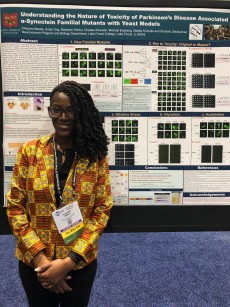Year Fifteen: Emerging Properties
 Chisomo Mwale, Editor-in-Chief
Chisomo Mwale, Editor-in-Chief
Chisomo Mwale
Lake Forest College
Lake Forest, Illinois 60045
Dear Readers,
Thank you, on behalf of the Eukaryon editorial board, for investing your time into exploring this undergraduate life science journal. Eukaryon would not have seen its 15th consecutive year without your continued support. This year saw many changes from the official opening of the Lillard Science Center to the introduction of the Biochemistry and Molecular Biology major at the college. And even with these changes, Eukaryon’s mission has always been to showcase the hard work students put in to produce thought-provoking research projects, academic scholarship and educational feature articles. All this is made possible by the diligent efforts of the editorial board whose pieces work together magnificently to make an amazing puzzle. This year’s theme, Emergent Properties, was inspired by how the different functions of each board, is able to produce a unique and cohesive unit when made to function with the other boards.
An emergent property is a property which a collection or complex system has, but which the individual members do not have. To put this into context, a single ant is a rather limited organism, with little ability to reason or accomplish complex tasks. As a whole, however, an ant colony accomplishes astounding tasks, from building hills and dams to finding and moving huge amounts of food. The beauty about emergent properties is that they occur everywhere from simple biological systems to complex economic ones. In this context, emergent properties are the changes that occur in ant behavior when individual ants work together and it is heavily dependent on the collaborative efforts of each individual ant.
The journal you are currently reading is similar to this ant analogy. It is a result of the individual contributions of Eukaryon’s editorial board. The work done would have been impossible, or would at least take a significant amount of time, to do if it were in the hands of a single person. As with the emergent properties of the ant colony, Eukaryon’s main function was only achievable through the collective work of individual members. The editorial board is comprised of many talented and bright students, and their hard work drives the machine. Every year, the goal is to improve upon the preceding year but this is only feat is only possible with a reliable team. My team went above and beyond, and did more than what was asked of them, and I will always be grateful.
This year, we are honoured to listen to Dr. William Conrad, a recent addition to the college’s Biochemistry and Molecular Biology department. Dr. Conrad is an associate professor of Chemistry at Lake Forest College. He received a bachelor of arts in Biology at Macalester College, another small liberal arts school. He went on to pursue a doctoral degree in Pharmacology, then proceeded to conduct a Postdoctoral Fellowship in Microbiology and Immunology at the University of Washington and then another Fellowship in the Medicine at the University of Cambridge. His current research focus is on determining the underlying molecular mechanisms of mycobacterium tuberculosis infection using zebrafish. He teaches Molecular Biology and the Molecular Machines senior seminar at the college. Dr. Conrad’s lecture, appropriately titled Emergence in Life and Science” will delve into the vital emergent properties within his research and will connect to the value emergence has in our daily lives. Many scientific discoveries relied on the individual contributions of team members to make the bigger picture make sense. Dr. Conrad has become a unique, yet integral part of the puzzle and is adding the college’s emergent properties.
Eukaryon has received continuous support from many faculty and staff members throughout the years, and the success of the journal could not have possible without them. Dr. Maine, has served as our advisor for a number of years, and has been a constant source of direction, guidance and advice. Her invaluable knowledge saw us through many road blocks and her encouragement allowed us to push through. I would also like to acknowledge Dr. Shubhik DebBurman for his continued support and advice. A special thank you needs to be given to Dr. Tracey McCabe, Director of Writing Programs and Senior Lecturer in English, for her invaluable assistance. I would also like to thank Cory Stevens, Head of Public Services and Collection Development, Allen Olson, Assistant Director of Visual Communications, and Patti Headley, Department Assistant for all of their instrumental assistance and indirect support. I would also like to thank Lake Forest College for their continued investment in our journal. Finally, thank you to all the faculty and students that submitted to Eukaryon. There is no Eukaryon without your submissions. Thank you for granting us the opportunity to publish your exceptional work. We hope you enjoy this year’s edition.
Sincerely,
Chisomo Mwale
Editor-in-Chief, Eukaryon, 2018-2019